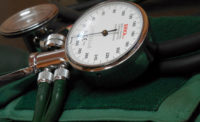Playing college football linked with high blood pressure risk
More than half of first-year players developed high blood pressure during the season

 College football players, especially linemen, may develop high blood pressure over the course of their first season, according to a small study in the American Heart Association’s journal Circulation.
College football players, especially linemen, may develop high blood pressure over the course of their first season, according to a small study in the American Heart Association’s journal Circulation.
Researchers documented higher blood pressure levels among 113 first-year college players. Only one player had already been diagnosed with hypertension before the season and 27 percent had a family history of hypertension. At post-season, researchers noted:
- 47 percent of players were considered pre-hypertensive, while
- 14 percent had stage 1 hypertension.
While previous studies indicate blood pressure elevation during adolescence and young adulthood can increase heart disease and heart-related death later in life, the unique findings of this study suggest early careful monitoring of young football players and timely treatment could improve their heart health later in life.
“High blood pressure is not a good thing at any point in life, but especially during the first two decades,” said the study’s senior investigator, Aaron L. Baggish, M.D.
"Shouldn't scare players"
“The findings shouldn’t scare players,” said Baggish, associate director of the Cardiovascular Performance Program at Massachusetts General Hospital. “The earlier in life we can identify and begin treating it the better, and identifying special at-risk groups, like these players, is essential.”
From 2006-11, researchers at Massachusetts General Hospital, Harvard Medical School, and Harvard Department of Athletics tracked blood pressure changes among players on the Harvard University team, before and after their first season. Researchers also examined changes in endurance-trained competitive rowers, but found no corresponding increase in blood pressure, suggesting the phenomenon may be related to periodic episodes of intense exertion such as football, Baggish said.
Overall, blood pressure levels averaged 116/64 millimeters of mercury (mm Hg) – which is normal – before the season, but afterward rose to an average 125/66 mm Hg, which is pre-hypertensive.
Players on the offensive or defensive line who gain weight during the season and have a family history of high blood pressure were most likely to have post-season hypertension.
Heart changes, too
Researchers also noted structural changes in players’ left ventricle, the heart’s main pumping chamber, which can be a potential indicator of worsening heart health since it can grow thicker if the chamber is overworked. In this study, left ventricle thickening (left ventricular hypertrophy) was more prevalent among football players than endurance athletes, and it was significantly greater among linemen.
“Importantly, left ventricular hypertrophy among football players was strongly associated with resting blood pressure suggesting that heart remodeling in some athletes may be due to what happens off the playing field,” he said.
More studies needed
“Considering the popularity of football in the United States, I believe this knowledge of an association with enhanced prevalence of prehypertension and stage 1 hypertension after one season in some players is extremely important,” said American Heart Association spokesperson Ernesto Schiffrin, M.D., Ph.D., who is not affiliated with the study. “However, the study should not be interpreted to mean that playing football causes hypertension. Instead, it suggests increased surveillance particularly in those most susceptible: those with a family history of hypertension or playing on the offensive or defensive line.”
Professional football players tend to have higher rates of both hypertension and premature death from heart disease, especially linemen, Baggish noted. He and his colleagues are continuing to monitor players identified as at-risk to gain a better understanding of hypertension and heart disease, if and when it develops, as they age.
Co-authors are Rory B. Weiner, M.D.; Adolph M. Hutter, Jr., M.D.; Rajeev Malhotra, M.D.; Jonathan H. Kim, M.D.; Michael H. Picard, M.D.; Stephanie K. Isaacs; Thomas J. Wang, M.D.; Francis Wang, M.D. and Brant Berkstresser.
Looking for a reprint of this article?
From high-res PDFs to custom plaques, order your copy today!








